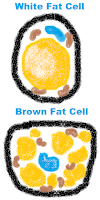There are two good reasons to measure body composition. It provides an objective way to track progress towards better health or fitness, and it directly affects performance.
ASSESS TO PREVENT OBESITY:
There are short term and long term changes that a fat cell can undergo. Think of the fat cell as a balloon that duplicates itself after reaching its maximum size. When fat intake rises, the first physiological change that occurs is an increase in size (up to 10x larger) caused by the storage of lipids (3). This is a short term change which can be restored through dietary and exercise interventions. If nothing is done to reduce the amount of lipids stored in each fat cell, eventually the fat cell will undergo cell division as well as the maturation of precursor cells to fat cells (2,3). Basically, you'll end up with more fat cells than you started with. Generally, someone with a normal percentage of body fat has about 30 to 50 billion fat cells whereas an obese individual can have 75-80 billion fat cells (3).
If the new fat cells have time to mature, they will also (permanently) remain the same size despite a significant loss of body fat (4). In other words, the balloons will deflate, but they'll remain on standby; eagerly waiting to store more fat. This is a major reason why obese people who successfully loses weight cannot maintain the weight loss. This is why body composition tracking is extremely important.
BODY COMPOSITION TESTING BENEFITS EVERYONE:
Just as important as it is to prevent excess body fat, it's also important to prevent body fat from getting too low. Young women and athletes who benefit from a low body weight are particularly at risk for eating disorders (1). Pay attention to the fine line between attention and obsession with regards to body weight or composition.
There are short term and long term changes that a fat cell can undergo. Think of the fat cell as a balloon that duplicates itself after reaching its maximum size. When fat intake rises, the first physiological change that occurs is an increase in size (up to 10x larger) caused by the storage of lipids (3). This is a short term change which can be restored through dietary and exercise interventions. If nothing is done to reduce the amount of lipids stored in each fat cell, eventually the fat cell will undergo cell division as well as the maturation of precursor cells to fat cells (2,3). Basically, you'll end up with more fat cells than you started with. Generally, someone with a normal percentage of body fat has about 30 to 50 billion fat cells whereas an obese individual can have 75-80 billion fat cells (3).
 |
| After the original fat cell undergoes hypertrophy (enlargement), it remains the same size even when emptied. |
BODY COMPOSITION TESTING BENEFITS EVERYONE:
Just as important as it is to prevent excess body fat, it's also important to prevent body fat from getting too low. Young women and athletes who benefit from a low body weight are particularly at risk for eating disorders (1). Pay attention to the fine line between attention and obsession with regards to body weight or composition.
WHO BENEFITS THE MOST FROM REGULAR BONE DENSITY TESTING? The older population benefits the most, especially those who are at a higher risk of falling. Early detection helps determine if the current regimen of exercise, nutrition, and supplementation is adequate. Surprisingly, road cyclists, including professional cyclists, also have a high risk of developing sarcopenia or below normal bone density.
THE SEVEN WAYS TO MEASURE BODY FAT:
There are six popular ways to measure body fat. I ranked the assessments based on most accurate (#1) to least accurate (#6).
- Body Fat Assessment #1: Hydrostatic weighing
- Body Fat Assessment #2: Skinfold Meaurements
- Body Fat Assessment #3: Bioelectrical Impedance
- Body Fat Assessment #4: Body Circumference
- Body Fat Assessment #5: Waist to Hip / Waist Circumference
- Body Fat Assessment #6: Body Mass Index "BMI
REFERENCES:
- Kaminsky, Leonard A..ACSM's health-related physical fitness assessment manual. 3rd ed. Philadelphia: Wolters Kluwer Health/Lippincott Williams & Wilkins Health, 2010. Print.
- Malina, R. M., C. Bouchard, O. Bar-Or (2nd ed.): Growth, Maturation and Physical Activity. Champaign, IL: Human Kinetics (2004).
- Plowman, Sharon A., and Denise L. Smith. Exercise physiology for health, fitness, and performance. 3rd ed. Philadelphia: Wolters Kluwer Health/Lippincott Williams & Wilkins, 2011. Print.
- Sjöström, L., & P. Björntorp: Body composition and adipose tissue cellularity in human obesity. Acta Medica Scandinavica. 195:201–211 (1974)
- Malina, R. M., C. Bouchard & O. Bar-Or: Growth, Mat-uration and Physical Activity (2nd ed.) Champaign, IL: Human Kinetics, 163 (2004). Reprinted by permission.





